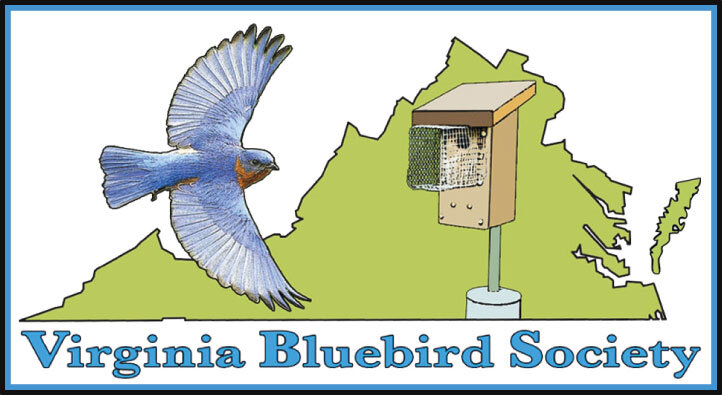Bluebird Monitoring Information
Bluebird Nesting Characteristics
Bluebirds make neat, cup-shaped nests of dry grass or pine needles (may have a few feathers mixed in).
Bluebird eggs are pale blue or white (never spotted).
Nest building takes 4 to 5 days but may be built in as few as 2 days.
Early in the season, nest building may take weeks to occur, so do not clean out early nest attempts if you do not see activity for a while.
Bluebirds lay 4 to 6 eggs the first time, average of 5 in Va. – one each day. The female begins incubation only after all eggs are laid so that all eggs will hatch on the same day [more under “Tips” below].
Average incubation time is 12 to 14 days.
Young grow and develop and are ready to fledge after 17-21 days depending on the weather and availability of food. (link to NABS Nestling Growth Chart)
Bluebirds in warmer climates will make two to three nest attempts in a season.
The Bluebird Book by Donald and Lillian Stokes (p. 83) is a good reference on estimating the age of nestling bluebirds.
We have developed a Bluebird Nesting Guide sheet which may be of use when monitoring to keep track of what to expect each time you open an active nest box. It incorporates most of the information shown above.
Tips on Monitoring Nest Boxes
Take note of adult birds seen in the area of the box.
Keep accurate records in order to keep other trail monitors on your trail well informed.
Try to know the date the last egg was laid so you can more accurately estimate when incubation begins and/or the age of the nestlings (average hatch date is two weeks after last egg is laid). For good photos of ages of nestlings, click here, or go to the Bluebird Chick Development guide from the Bluebird Restoration Association of Wisconsin.
If nestlings are 13 days or older, do not open the box. (Opening box may cause 12+ day old fledglings to fledge prematurely. When in doubt, don’t open the box.).
Monitor only during calm, mild or dry weather to prevent chicks from being chilled.
Opening the Box
Stand away from front entrance of box.
Do not tap on the box, but make noise as you approach the box to warn the bluebirds that you are coming.
Open the box carefully in case the female is still inside, and note: number of eggs or nestlings, and approx. age of nestlings.
Also note things like partial or complete nests, nest material used, predation that may have occurred, infestations (ants, blowflies…), any work or repairs needed for box.
Record this information for bluebirds and other native cavity nesters using the box.
Make sure the box is closed securely when you leave.
After the Bluebirds Have Fledged
After you are sure the young have fledged and the box is empty, open the box and check for any unhatched eggs and note this in your records.
Check for dead babies. Try to account for all eggs that were in the nest to get an accurate fledgling count.
Remove the old nest. If you find blowflies or their larvae, spray the box with a weak solution of pyretherin (1%) and leave the box open for 24 to 48 hrs.
Equipment for Monitoring
For trails monitored by a team, we recommend assembling the following equipment in a 5 gallon bucket and keeping it in a central location where team members can pick it up prior to monitoring.
Bucket… to carry supplies. You can also turn upside down and stand on it to get a better view inside a nest box, but be careful.
Field Notebook… to keep an account of what is happening on your trail.
Pencil or Pen… to make notes in the field notebook.
Mirror… to aid in viewing inside nest boxes if it is difficult to see inside.
Gloves… oil on your hands may attract predators.
Screwdriver… for opening the box.
Alcohol Hand Sanitizer… to use on your hands frequently while monitoring to help prevent the spread of harmful bacteria.
Plastic Bags… to carry away any sparrow or old bluebird nests. Don’t drop nesting material on the ground near the box – this attracts predators. Encourage team members to bring new supplies.
Paintbrush… to clean out box. Many of us also include a toothbrush for rough spots and corners.
Small Bar of Mild Soap… used to rub on interior of next box to discourage nesting by wasps.
Note: You may also want to bring a small flashlight, camera and a pair of binoculars for your own use.
